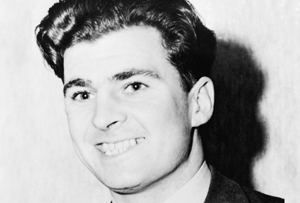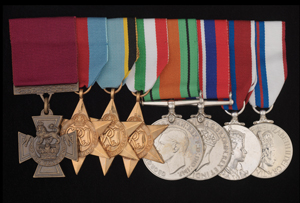Norman Cyril Jackson VC
Name: Norman Cyril Jackson
Conflict: Second World War
Gazetted: October 26, 1945
Service: Royal Air Force Volunteer Reserve

Norman Cyril Jackson VC

Medal group
Place/date of birth: Ealing, London/April 8, 1919
Rank when awarded VC (and later highest rank): Sergeant (later Warrant Officer)
Date of bravery: April 26/27, 1944
London Gazette citation:
905192 Sergeant (now Warrant Officer) Norman Cyril JACKSON, R.A.F.V.R., 106 Squadron.
This airman was the flight engineer in a Lancaster detailed to attack Schweinfurt on the night of 26th April, 1944. Bombs were dropped successfully and the aircraft was climbing out of the target area. Suddenly it was attacked by a fighter at about 20,000 feet. The captain took evading action at once, but the enemy secured many hits. A fire started near a petrol tank on the upper surface of the starboard wing, between the fuselage and the inner engine.
Sergeant Jackson was thrown to the floor during the engagement. Wounds which he received from shell splinters in the right leg and shoulder were probably sustained at that time. Recovering himself, he remarked that he could deal with the fire on the wing and obtained his captain’s permission to try to put out the flames.
Pushing a hand fire-extinguisher into the top of his life-saving jacket and clipping on his parachute pack, Sergeant Jackson jettisoned the escape hatch above the pilot’s head. He then started to climb out of the cockpit and back along the top of the fuselage to the starboard wing. Before he could leave the fuselage his parachute pack opened and the whole canopy and rigging lines spilled into the cockpit.
Undeterred, Sergeant Jackson continued. The pilot, bomb aimer and navigator gathered the parachute together and held on to the rigging lines, paying them out as the airman crawled aft. Eventually he slipped and, falling from the fuselage to the starboard wing, grasped an air intake on the leading edge of the wing. He succeeded in clinging on but lost the extinguisher, which was blown away.
By this time, the fire had spread rapidly and Sergeant Jackson was involved. His face, hands and clothing were severely burnt. Unable to retain his hold, he was swept through the flames and over the trailing edge of the wing, dragging his parachute behind. When last seen it was only partly inflated and was burning in a number of places.
Realising that the fire could not be controlled, the captain gave the order to abandon aircraft. Four of the remaining members of the crew landed safely. The captain and rear gunner have not been accounted for.
Sergeant Jackson was unable to control his descent and landed heavily. He sustained a broken ankle, his right eye was closed through burns and his hands were useless. These injuries, together with the wounds received earlier, reduced him to a pitiable state. At daybreak he crawled to the nearest village, where he was taken prisoner. He bore the intense pain and discomfort of the journey to Dulag Luft with magnificent fortitude. After 10 months in hospital he made a good recovery, though his hands require further treatment and are only of limited use.
This airman’s attempt to extinguish the fire and save the aircraft and crew from falling into enemy hands was an act of outstanding gallantry. To venture outside, when travelling at 200 miles an hour, at a great height and in intense cold, was an almost incredible feat. Had he succeeded in subduing the flames, there was little or no prospect of his regaining the cockpit. The spilling of his parachute and the risk of grave damage to its canopy reduced his chances of survival to a minimum. By his ready willingness to face these dangers he set an example of self-sacrifice which will ever be remembered.
Click here to see full Gazette entry.
Other decorations: N/A
Place/date of death: Hampton Hill, London/March 26, 1994
Grave/memorials: Percy Road Cemetery, Twickenham, Middlesex
Origin of VC to the Lord Ashcroft collection: Purchased at auction, Spink, London, 2004
Current location of VC: Displayed on rotation at The Lord Ashcroft Gallery: Extraordinary Heroes exhibition, Imperial War Museum